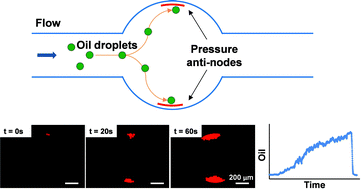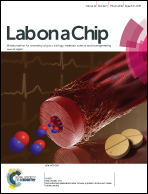Microfluidic acoustophoretic force based low-concentration oil separation and detection from the environment†
Abstract
Detecting and quantifying extremely low concentrations of oil from the environment have broad applications in oil spill monitoring in ocean and coastal areas as well as in oil leakage monitoring on land. Currently available methods for low-concentration oil detection are bulky or costly with limited sensitivities. Thus they are difficult to be used as portable and field-deployable detectors in the case of oil spills or for monitoring the long-term effects of dispersed oil on marine and coastal ecosystems. Here, we present a low-concentration oil droplet trapping and detection microfluidic system based on the acoustophoresis phenomenon where oil droplets in water having a negative acoustic contrast factor move towards acoustic pressure anti-nodes. By trapping oil droplets from water samples flowing through a microfluidic channel, even very low concentrations of oil droplets can be concentrated to a detectable level for further analyses, which is a significant improvement over currently available oil detection systems. Oil droplets in water were successfully trapped and accumulated in a circular acoustophoretic trapping chamber of the microfluidic device and detected using a custom-built compact fluorescent detector based on the natural fluorescence of the trapped crude oil droplets. After the on-line detection, crude oil droplets released from the trapping chamber were successfully separated into a collection outlet by acoustophoretic force for further off-chip analyses. The developed microfluidic system provides a new way of trapping, detecting, and separating low-concentration crude oil from environmental water samples and holds promise as a low-cost field-deployable oil detector with extremely high sensitivity. The microfluidic system and operation principle are expected to be utilized in a wide range of applications where separating, concentrating, and detecting small particles having a negative acoustic contrast factor are required.


 Please wait while we load your content...
Please wait while we load your content...